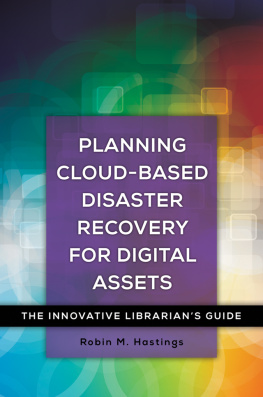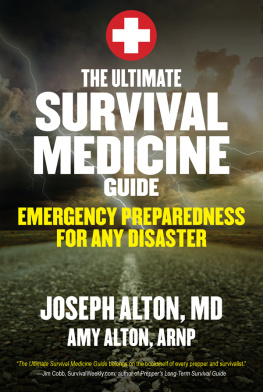Crash Course in Disaster Preparedness
Recent Titles in Libraries Unlimited Crash Course Series
Crash Course in Collection Development, Second Edition
Wayne Disher
Crash Course in Marketing for Libraries, Second Edition
Susan W. Alman and Sara Gillespie Swanson
Crash Course in Readers' Advisory
Cynthia Orr
Crash Course in Storytime Fundamentals, Second Edition
Penny Peck
Crash Course in Basic Cataloging with RDA
Heather Lea Moulaison and Raegan Wiechert
Crash Course in Weeding Library Collections
Francisca Goldsmith
Crash Course in Technology Planning
Christopher D. Brown
Crash Course in Library Budgeting and Finance
Glen E. Holt and Leslie E. Holt
Crash Course in eBooks
Michele McGraw and Gail Mueller Schultz
Crash Course in Contemporary Reference
Francisca Goldsmith
Crash Course in Young Adult Services
Sarah Flowers
Crash Course in Time Management for Library Staff
Brenda Hough
Crash Course in Disaster Preparedness
Carmen Cowick
Crash Course
Copyright 2018 by Carmen Cowick
All rights reserved. No part of this publication may be reproduced, stored in a retrieval system, or transmitted, in any form or by any means, electronic, mechanical, photocopying, recording, or otherwise, except for the inclusion of brief quotations in a review, without prior permission in writing from the publisher.
Library of Congress Cataloging-in-Publication Data
Names: Cowick, Carmen, 1981-author.
Title: Crash course in disaster preparedness / Carmen Cowick.
Description: Santa Barbara, California : Libraries Unlimited, 2018. | Series: Crash course | Includes bibliographical references and index.
Identifiers: LCCN 2018019356 (print) | LCCN 2018020982 (ebook) | ISBN 9781440860522 (ebook) | ISBN 9781440860515 (paperback)
Subjects: LCSH: Library buildingsSafety measuresPlanning. | Emergency managementPlanning. | Library materialsConservation and restorationPlanning. | LibrariesInformation technologySecurity measuresPlanning.
Classification: LCC Z679.7 (ebook) | LCC Z679.7 .C68 2018 (print) | DDC 025.8/2dc23 LC record available at https://lccn.loc.gov/2018019356
ISBN: 978-1-4408-6051-5 (paperback)
978-1-4408-6052-2 (ebook)
22 21 20 19 18 1 2 3 4 5
This book is also available as an eBook.
Libraries Unlimited
An Imprint of ABC-CLIO, LLC
ABC-CLIO, LLC
130 Cremona Drive, P.O. Box 1911
Santa Barbara, California 93116-1911
www.abc-clio.com
This book is printed on acid-free paper 
Manufactured in the United States of America
Contents
Chapter 1
Introduction to Disaster Planning
Introduction
Disasters are not a matter of if it will happen to your institution, but rather when it will happen to your institution. Unfortunately, disasters are inevitable, and that is why the planning for such an occurrence needs to be done well ahead of time so that sufficient training can be carried out and the response to the disaster can be swift and effective. Preparedness involves caring for both your users and staff as well as your facility and your collection. Preparedness means doing your best to prevent any disasters from occurring, knowing how to respond to disasters when they occur, and working together to successfully recover from a disaster.
The first step to being prepared is to create a team of staff members who will aid in prevention, response, and recovery during an emergency or disaster. This team will be known as the disaster team. Each member of the team will have different roles and responsibilities, which will be discussed in depth in this chapter.
After organizing your disaster team, you and the team will work together to create a disaster plan. This chapter concludes with developing this plan so that it will contain everything you need to successfully combat a disaster.
Organize a Disaster Team
The disaster team should consist of a team leader and six coordinators. If you have sufficient staff, each coordinator should have at least one or two assistants. You may also consider asking coworkers outside the library for assistance if your staff is insufficient. For instance, if your library is a branch of a larger library system, you may be able to coordinate with another library and offer each other mutual assistance. Or if your library is on a college campus, consider who might be able to help you fill out your disaster team. Another option may be recruiting volunteers, though you should always check with your administration and get approval before doing so. Each coordinator should have an alternative in the event that person is not available. All assistants should report to their respective coordinators, and all coordinators should report to the disaster team leader.
Disaster Team Leader
The job of the disaster team leader is to oversee and manage the coordinators and act as a mediator should conflicts arise. The team leader will be responsible for evaluating all emergencies and declaring when the disaster plan will go into effect. During an evacuation, the team leader will be responsible for assigning the rest of the team members an area to evacuate. The team leader will also have the ability to authorize the purchase of necessary supplies and equipment as well as any emergency expenditures that are needed such as the hiring of a conservator or a mold removal service.
In choosing the disaster team leader, you need to ensure that this person is someone who is comfortable taking charge, making decisions, and managing a group of people. While the disaster team leader can seek the advice of the other members of the team, he or she will ultimately be responsible for the final decision of what actions to take.
Risk Assessment Coordinator
Because there are so many types of disasters or emergencies that can befall us, it would be impossible to be prepared for all of them; there simply are not enough hours in the day. The best thing that can be done is to undertake a risk assessment for the institution. The risk assessment coordinator must assess the risks most likely to occur at your library and should work with the team to develop procedures to eliminate or reduce the impact of those risks should they arise. Time is limited, and your focus should be on disasters and emergencies that the library is more likely to experience than not. In other words, you do not want the disaster team focusing on hurricane prevention response and recovery if you are located in Kansas. Instead you could be focusing on tornado prevention, response, and recovery, as this situation is far more likely to occur than a hurricane. The risk assessment coordinator will be responsible for day-to-day inspections of the building and the collections, evaluating the probability of occurrence for all types of disasters, and reevaluating those probabilities after a disaster or emergency occurs. In other words, the initial risk assessment for the occurrence of a hurricane might have been set as low risk, but if, for example, the library is hit by two hurricanes in two years, the risk assessment coordinator would be wise to change the risk level to high.
Operations Coordinator
The job of the operations coordinator is to oversee the overall operations of disaster planning and to ensure that all costs and losses are accurately tracked and documented. This means that the operations coordinator will mainly be in charge of procuring and replenishing salvage supplies and equipment, working with the team leader to authorize any emergency expenditures that may occur during a disaster, contacting the institution's insurance agent, and contacting any local, state, or federal authorities for any eligible financial assistance. If additional team members need to be recruited from outside your library staff, it is the operations coordinator who will take on this task.
















